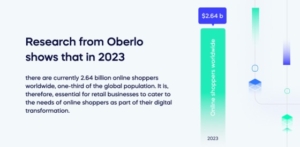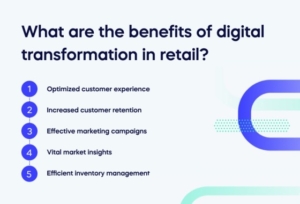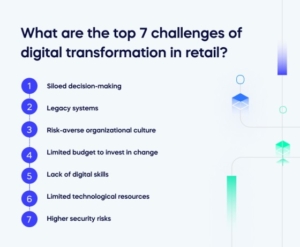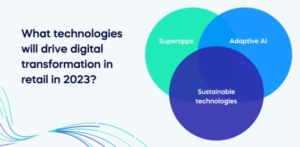Of all the fields of industry, the retail market is the most customer-facing, and customers love nothing more than seeing a bit of shiny new tech like ChatGPT or augmented reality to augment their shopping experience.
This is why customer engagement forms the core of success for digital transformation in retail.
We can see the importance of digital transformation in retail in 2021 and 2022 and the explosion in online retailers, as lockdowns prevented shoppers from attending retail outlets in person.
These habits have stuck with shoppers, as Statista shows that the US spent 1 trillion dollars online in 2022.

But despite the benefits of digital transformation in retail, it also comes with many challenges. Strategic planning and focused investment in new digital tools are needed to overcome these challenges.
To cover every aspect of digital transformation in retail, let’s explore the following topics:
- Why is digital transformation vital in 2023?
- What are the benefits of digital transformation in retail?
- What are the challenges of digital transformation in retail?
- What technologies will drive digital retail transformation beyond 2023?
Why is digital transformation vital in 2023?
Digital transformation is essential in 2023 more than ever, as the progress and adoption of technologies like online shopping have increased at an unprecedented speed since the beginning of the Covid-19 epidemic and resulting lockdowns.

Research from Oberlo shows that in 2023 there are currently 2.64 billion online shoppers worldwide, one-third of the global population. It is, therefore, essential for retail businesses to cater to the needs of online shoppers as part of their digital transformation.
What are the benefits of digital transformation in retail?

There are many benefits to digital transformation in retail, starting with optimized customer experience for your retail business.
Please see the short video below, which describes many of the benefits of digital transformation in retail.
Digital Transformation for Retailers: Connect to Consumers In-Store and Online with NCR
1. Optimized customer experience
Retailers can use digital technologies to provide an omnichannel customer experience, which means customers can receive help and support through various channels like websites, mobile apps, email, and live chat.
Digital transformation enables customers to use self-service options like a chatbot to submit questions and complaints anytime, receiving real-time customer support. This technology helps customers complete their journey with minimal interactions, resulting in cost savings for retailers.
2. Increased customer retention
When companies implement digital transformation in retail effectively, customers are happier and more loyal and want to see what they have to offer in the future.
Everyone likes to feel ahead of the curve, and constantly implementing new technology makes you and your customers feel like they are on the cutting edge of tech advancements.
3. Effective marketing campaigns
Retailers can use digital transformation to gather customer data using CRM, data analytics, and marketing automation technologies. This enables them to create personalized and focused marketing campaigns.
Doing so allows retailers to identify customer behaviors while providing insights into their target audiences. Access to such information reduces the cost of marketing activities and helps tweak marketing campaigns with changing customer behavior.
4. Vital market insights
The analysis of consumer data can provide valuable information about the market. Retailers can then use this information to identify specific actions and strategies to increase their growth and profitability.
The insights assist retailers in understanding their customers better, enabling them to establish a strong relationship with them. This relationship ultimately drives growth and is a critical factor in achieving success.
5. Efficient inventory management
Efficient inventory management can be achieved in the retail industry through technology and data. Retailers can benefit from digital technologies to automate and streamline their inventory processes, improving operational efficiency.
This transformation facilitates quick order fulfillment, warehouse management, lead time calculations, and safety stock maintenance to avoid stock-outs.
What are the top 7 challenges of digital transformation in retail?

There are many challenges to overcome before you reap the rewards of digital transformation in retail, the first of which is siloed decision-making.
1. Siloed decision-making
Digital transformation in retail is hindered by organizational silos that create obstacles at every stage, including strategy development and implementation.
The presence of silos in an organization results in each team or department focusing solely on their objectives and problem-solving, which can lead to independent decision-making.
This lack of a unified vision can restrict efficiencies and hinder digital innovation, making it challenging for every team to work together toward achieving a common business goal.
2. Legacy systems
Enterprises often struggle to step outside their comfort zone in their retail business, as evidenced by their continued use of legacy systems.
Despite the availability of more agile and robust platforms, they opt to stick with these old systems because they have already invested significant capital and are still benefiting from them.
Legacy is a significant obstacle to digital transformation due to outdated software and technology. They are slow and inflexible, hindering the adoption of new technologies and transitions. In addition, their vulnerability to security breaches is a significant concern.
3. Risk-averse organizational culture
Many retail businesses have a culture that is hesitant to change, hindering their growth and progress.
This attitude is particularly prevalent when trying to implement digital transformation in retail. This resistance is seen among employees and C-level executives, often preventing them from embracing new technologies.
Businesses that stick to their current practices may not see the benefits of digital transformation, even if they are successful.
This can lead to employees feeling unsure about their new roles and responsibilities. Not addressing these concerns could result in missed opportunities for growth.
4. Limited budget to invest in change
Due to financial constraints caused by the pandemic, businesses that suffered significant losses may have been unable to invest in digital transformation practices. Implementing new digital solutions is a costly process that requires substantial investments.
Another common mistake is considering technology expenses to be only operational costs. This results in businesses not recognizing the importance of strategically investing in digital transformation and allocating inadequate budgets.
Consequently, proper implementation is hindered, negatively affecting future agility and adaptability.
5. Lack of digital skills
As companies embrace digital transformation, digital skills will become essential for almost every job, including non-technical roles. This means that the current range of digital skills may not be enough for a successful transformation.
The shortage of skilled professionals in critical areas worsens the digital skills gap. Proficiency in analytics, cloud computing, cybersecurity, enterprise architecture, digital experience, and other fields is essential for successful digital transformation.
However, locating the appropriate personnel within a restricted talent pool can be challenging and costly.
6. Limited technological resources
In addition to the shortage of skilled workers, businesses are also experiencing a scarcity of other vital resources needed to implement digital projects. One major obstacle affecting numerous industries in 2023 is the worldwide shortage of microchips.
Furthermore, there is an ongoing supply chain for IT hardware and equipment. This lack of resources prevents companies from promptly deploying sufficient project tools.
7. Higher security risks
Due to the abrupt shift in consumer demands, many companies hurriedly incorporated digital solutions without considering the possible cybersecurity risks. As a result, they became more susceptible to cyber-attacks.
Now, other businesses are hesitant to pursue their digital initiatives, afraid they might fall prey to the same security breaches.
What technologies will drive digital transformation in retail in 2023?

Many technologies are likely to drive digital transformation in retail in 2023, and it is essential to research these technologies in advance to stay ahead of the curve and exceed the success of your competitors.
See the short video below for a visual representation of some technologies that every retailer needs to succeed in the future.
5 Technologies That Every Retailer Needs to Succeed [Digital Transformation in Retail]
Superapps
Superapps are not just apps that group services together. They have the characteristics of an app, platform, and ecosystem. This allows third-party developers to create and release their mini-apps within the super-app.
Streamline production and design using fewer apps, and reduce waste with fewer overlapping apps in your app matrix. Also, more collaboration via a streamlined communication process due to a smaller, more interdisciplinary app tech stack.
All these optimizations translate back to improved customer service as every team in your organization can communicate more efficiently with each other and customers.
Adaptive AI
Adaptive AI is a technology that enables model behavior to be changed after deployment by using real-time feedback. Doing so allows for continuous retraining of the models and learning within both runtime and development environments.
The process is based on new data and adjusted goals, which enables quick adaptation to changing real-world circumstances for retail stores and designers.
Sustainable technologies
STAT customers care about the ecology of products today. It is helpful to speak to this customer segment by visibly showing you the design and manufacture of retail products with sustainability in mind.
By using data-driven dashboards, it is possible to collect and showcase metrics about the environmental impact of a product throughout its entire lifecycle. This ensures the product’s ecological footprint is visible to the buyer before purchasing.
Streamline your digital transformation in retail with a DAP
There are many factors to consider when embarking on a digital transformation in retail because customers want to buy products using the latest technologies. And despite challenges such as legacy systems and siloed decision-making, digital transformation in retail has many benefits to customer service and retention.

The best way to align your company goals successfully with digital transformation in retaliation implementation is using a DAP (digital adoption platform). The in-app guidance and personalized learning of the DAP reduce resistance to change to ensure a successful omnichannel retail digital transformation.


